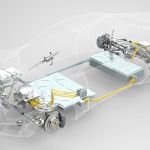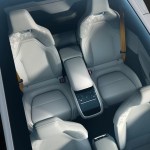San Francisco-based Bedrock Robotics emerged from stealth today, announcing $80 million in Seed and Series A backing in its mission to develop advanced autonomous systems for the global construction industry, estimated by McKinsey & Company to be a $13 trillion opportunity. Rather than design and sell new machinery, like Teleo, the startup upgrades customers’ existing heavy-equipment fleets. It does it with reversible, same-day hardware and software installs to enable fully autonomous operations.
The latest funding rounds, Series A led by 8VC and Seed led by Eclipse, will help Bedrock grow its engineering, operations, and commercialization teams, and deepen partnerships to reach its target of initial operator-less deployment in 2026. Bedrock’s fundraising has also included participation from Two Sigma Ventures, Valor Equity Partners, Nvidia‘s venture capital arm NVentures, Crossbeam Venture Partners, Raine Group, Tishman Speyer, Atreides Management, Al Rajhi Partners, and Samsara Ventures.
The company was founded in 2024 by three former Waymo engineering leaders—CEO Boris Sofman, CTO Kevin Peterson, and VP Engineering Ajay Gummalla—who helped pioneer the development and deployment of the first autonomous vehicles on public roads, and VP Engineering Tom Eliaz from Segment, who scaled complex engineering systems for the company. The executive team also includes COO Laurent Hautefeuille, who previously served as EVP and Chief Business Development Officer at Uber Freight, where he helped scale the business to $5 billion in revenue, and VP of Finance Bryan Hammes, also previously from Waymo.
Company executives believe the U.S. “needs to build like never before” for data centers to power the AI revolution, clean energy infrastructure, new housing units, and manufacturing facilities, “but can’t keep up.” They say that construction projects that should take months stretch into years while others sit stalled, but they aim to change that by enabling “building at the speed of societal need.”
The company says its technology bridges the expanding gap between rapidly rising domestic infrastructure needs and shrinking workforce capacity, citing numerous sources. In 2024, investment in U.S. manufacturing facilities reached a record $238 billion, according to Deloitte. Despite an Associated Builders and Contractors–estimated shortage of 500,000 construction workers, 1.25 billion hours are spent annually on operating heavy equipment, according to the U.S. Dept. of Labor‘s Bureau of Labor Statistics. With 40% of construction workers expected to retire in the next decade, according to NCCER research, the case for automation that enhances the availability and flexibility of labor for the industry has never been stronger.
“The construction industry is facing so much pressure with the soaring demand for new factories and data centers, the housing crisis, and the mandate for re-industrialization in the U.S.,” said Sofman. “The only way to rise to the occasion is by empowering construction teams with advanced automation they can trust. Together with our partners in the industry, we’re ushering in a new era where autonomy and intelligence supercharge building, which will benefit both contractors and society.
Waymo learnings
At Waymo, Sofman says that much of the Bedrock team spent years teaching robotaxis and trucks to safely navigate unpredictable city streets alongside humans.
“We helped put the first fully autonomous vehicles on public roads—systems that today operate across 4 cities, have accumulated over 70 million driverless miles, and operate at 5 times the safety of humans,” he said. “Our team also brings experience scaling high-scale cloud systems and operational expertise from growing companies like Uber Freight to $5 billion in revenue.”
One breakthrough that enabled Waymo’s impressive scale was shifting from traditional robotics approaches to a dominantly ML (machine learning) and data-driven system.
“This approach solved San Francisco’s diverse and nuanced driving scenarios while demonstrating strong generalization across cities, environments, and platforms—from the Waymo trucking program to the first driverless freeway launch for Waymo’s rideshare vehicles,” said Sofman. “This represents a fundamental shift from 25 years of traditional autonomy development, and one that our founding team saw a generational opportunity to apply to specialized heavy machines.”
He says that construction equipment faces the same challenge: operating safely and precisely in unpredictable environments across many types of complex tasks.
“Excavators, bulldozers, and loaders must understand site terrain, adapt to changing conditions, and execute intricate maneuvers with tons of steel,” said Sofman. “The difference is these machines don’t just navigate the world—they sculpt it with centimeter-level precision. The same ML approaches that enabled superhuman driving are critical for truly competent and scalable construction systems.”
Existing machine integration
By integrating with existing construction machines and workflows, the Bedrock Operator powers machines with expert capabilities, empowering builders with the ability to work around the clock, accelerate project schedules, increase profitability and safety, and track progress on jobs.
Key capabilities of the Bedrock Operator include “superhuman safety” with “unparalleled visibility” around equipment, meaning fewer surprises and greater worker safety. Environmental understanding allows for the navigation of hills, trenches, boulders, and obstacles on the job site while molding the land to the exact defined plan. Operational precision through large-scale ML models, trained on projects across the country, enables machines to complete tasks with expert-level quality and nuance. Real-time intelligence allows users to view metrics on progress and performance so they have the data needed to keep critical projects on track.
The system integrates eight cameras with lidar for a 360-degree field-of-view and a high-fidelity understanding of the work area. Survey-grade IMUs and GPS provide centimeter-precision localization, while LTE antennas keep worksites connected for real-time monitoring. Rugged casings protect components from harsh conditions, while state-of-the-art compute inside the cab serves as the brain behind the machine.
Starting with excavators, the company’s system is already running on machines at customer construction sites in Arizona, Texas, and Arkansas.
Bedrock Robotics recently teamed with three Texas firms: Zachry Construction, Champion Site Prep, and Capitol Aggregates. It also collaborates closely on field testing and product improvements with one customer, Phoenix-based general contractor Sundt Construction, which is looking for ways to expand operational capacity.
“From our earliest conversations with Bedrock, it was clear they had a strong grasp on the challenges we were trying to solve with robotics,” said Eric Cylwik, Director at Sundt Construction. “Their thoughtful approach to safety and deployment made it an easy decision to partner and pilot their system on our projects. When a technology proves its value in the field, this industry will pick it up fast.”
- Bedrock Robotics bucket and truck simulation.
- Boris Sofman is Bedrock Robotics’ Cofounder and CEO.
- Bedrock Robotics lidar simulation.
- Bedrock Robotics lidar simulation.
- Bedrock Robotics industrial design.
- Bedrock Robotics testing underway.























































































